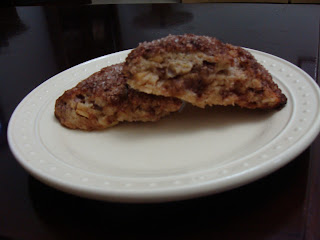This one can be added to the nothing is easy in Albania files...........I woke up the other day craving scones. After digging through my recipes I came across a recipe for
Fresh Apple Cinnamon Scones from King Arthur Flour. These would be the perfect goodie to fulfill my breakfast treat craving while getting in a dose of fruits (the apples of course). Plus the recipe called for the inclusion of
cinnamon chips and surprisingly enough, I had two whole bagfuls in the pantry. So what was the problem? The recipe also called for apple sauce.
Apple sauce is one of those surprising foods you just can't buy here in Albania. Yes it is simple enough to make your own but not having any on hand and not being able to run out to the grocery store to pick some up, suddenly turned my simple morning treat plans into something that wasn't so simple any more. I wouldn't be deterred though and with the scones still on my mind, I set about making a small batch of apple sauce.
 |
| Start with some apples |
 |
| Ready to be pureed |
As a baby Sidney was a huge fan of applesauce so for a period of time it felt as though I was making batches on a weekly basis. I don't follow a formal recipe for applesauce; rather I use what is on hand. For this batch I peeled, cored, and chopped up five medium sized red apples, added them to a pan with about a half cup of water and threw in a cinnamon stick. I let the mixture simmer over low heat for about twenty minutes. What resulted was a slightly tart and cinnamon infused puree. I could have eaten it as it was but that would have defeated the whole purpose for making the sauce. At last I could finally move on to my primary cooking project.
KING ARTHUR FLOUR'S APPLE CINNAMON SCONES
2 3/4 cups all-purpose flour
1/3 cup granulated sugar
3/4 tsp salt
1 tablespoon baking powder
1 tsp apple pie spice or ground cinnamon (I used ground cinnamon)
1/2 cup cold butter
3/4 c chopped fresh apple, cut in 1/2 " pieces (peeled mine but you can also leave the skin on)
3/4 cup cinnamon chips
2 large eggs
1 tsp vanilla extract (I make my own)
TOPPING
3 tbsp coarse white sparkling sugar
1/2 tsp ground cinnamon
DIRECTIONS
1) In a large mixing bowl, whisk together the flour, sugar, salt, baking powder and spice.
2) Work in the butter just until the mixture is unevenly crumbly; it is ok for some larger chunks of
butter to remain unincorporated.
 |
| Flour and butter |
3) Stir in the chopped apple and cinnamon chips.
4) In a separate mixing bowl, whisk together the eggs, vanilla, and applesauce.
5) Add the liquid ingredients to the dry ingredients and stir until all is moistened and holds together.
6) Line a baking sheet with parchment; if you don't have parchment, just use it without greasing it.
Sprinkle a bit of flour atop the parchment.
7) Scrape the dough onto the floured parchment paper or pan, and divide it in half. Gently pat and
round each half into a 5" to 5 1/2" circle about 3/4" thick.
8) To make the topping: stir together the course sugar and cinnamon. Brush each circle with milk, and
sprinkle with the topping.
9) Using a kitchen knife that you've run under cold water, slice each circle into 6 wedges.
10) Carefully pull the wedges away from the center to separate them just a bit; there should be about
1/2" of space between them, at their outer edges.
 |
| Ready for the oven |
11) For the best texture and highest rise, place the pan of scones in the freezer for 30 minutes,
uncovered. While the scones are chilling, preheat the oven to 425 degrees. (Do not skip the
freezer step).
12) Bake the scones for 18 to 22 minutes, or until they're golden brown.
13) Remove the scones from the oven, and cool briefly in the pan. Serve warm.
Yield: 12 scones
 |
Ready to eat |


























